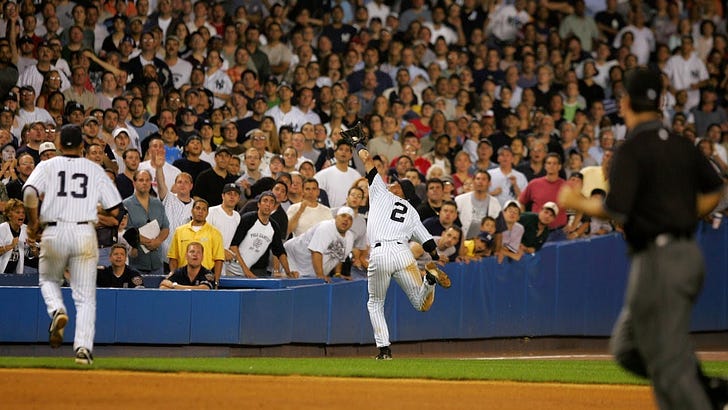I used to do a thing in an old Diamond Mind League where I’d start Dave Winfield in the infield when I had an extreme fly ball pitcher — and I had a couple. It would work because he was athletic and the game didn’t anticipate this, so with his chances reduced as much as possible, the hitting value of him over an early-80’s shortstop was huge and vastly outweighed any defensive cost.
Now, Diamond Mind is good but it’s not reality. As far as I know, no one’s tried something similar, but it wasn’t that long ago that Kevin Mitchell came up to the major leagues as a shortstop, or that Mark McGwire and Albert Pujols first played as Cardinals at third base. Could a team try something similar, moving someone up the defensive spectrum and how bad could it be?
First, let’s assume that almost all major leaguers were once shortstops. All you have to do is look at the draft to get that. Most aren’t major league shortstops, which is why they move. But could they hold the position for a couple innings? A game here or there? I’m just not sure on that. There’s some injury risk, though I don’t have the notes for that old study — I think middle infielders actually had less risk because they had the least contact with walls, though I’m sure Derek Jeter might have something to say on that.
I had trusty intern Jack Fitzgerald dig in on who the worst fielder was and the issue is that there’s been a quick evolution of defensive stats, first to calculated states like range factor and UZR, then to more observed stats from Statcast and Hawkeye. For breadth, I went with UZR and the worst covered by that would be Daniel Murphy. He cost 29.6 runs at second in his career, but he was bad across the spectrum. There’s not a positive UZR for any position. Born DH? Maybe, but the theoretical “worst defense ever” was never enough to cancel out the positive effects of his bat until his last few seasons.
I’m not sure this is worth it, but this came out of a conversation with Jon Weisman about Michael Busch, a mashing infielder at AAA who’s got a brutal defensive reputation. Busch was mostly a 4C at North Carolina, so someone had the idea that he could hold up in the middle infield. Scouts I spoke with said he was athletic and graded out at 50, an everyday major leaguer. Well, why not try? If he can’t field, you know and if he mashes, you know. Or do what the Braves did with Drew Waters and turn what you can’t use into something you can.
The Dodgers are an interesting case here since they have an entire company of analysts who could address this issue. In a launch angle world, a poor defensive infielder against a flyball hitting lineup with a flyball pitcher seems to be a calculable issue, if not downright knowable through minor league experience. We know Busch had 13 errors in 800 innings at AAA, behind a couple pitchers we’re likely to see in the Dodgers rotation at some point this year. The team was 84-66, so he couldn’t have hurt them badly. Max Muncy had 12 errors in 940 innings and yes, this isn’t apples to apples, but there’s not a huge difference apparent in the ink. It might be far different in reality, but my point here is that there’s a potential advantage hiding in plain sight.
Or not. Let’s get to the injuries:
BRYCE HARPER, OF/DH PHI (sprained elbow)
Bryce Harper isn’t in Phillies camp, but the team isn’t worried. He’s been cleared for dry swings - which is with a normal bat but no bat-to-ball contact, which does create significant shock - which is where he’d be expected to be at this point about five months post-TJS. The question now is whether he could return to DH at an earlier point than when he could return to full playing, including throwing. There’s no indication on either, but given there’s no reports of him throwing yet, even lightly outside of rehab, both seem a bit off given the Phillies utter caution with him.
Which is not to say being conservative is the wrong tack. The Phillies medical staff and Harper’s team, which includes the Boras Institute, certainly deserve the benefit of the doubt from outside. We simply don’t know all the facts out here and they do. For all my thoughts on all TJ rehabs being conservative, there’s still a personal risk for someone like Harper and a cautious, creeping rate is nothing if not safe, but it gets back.
The worst case at this point, absent an unexpected setback, is that he returns at or around the All Star break. Most position TJ returns are without incident and come back to level at the plate very quickly, since the UCL isn’t loaded or stressed by a normal swing. (Yes, there’s a single exception …) Harper’s recovery and return is on track, which is good news for baseball and especially for the Phils.




